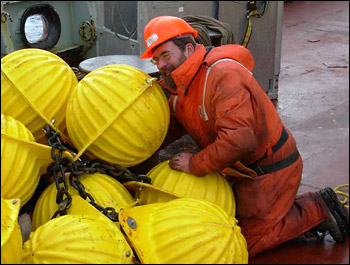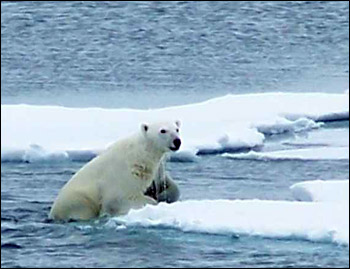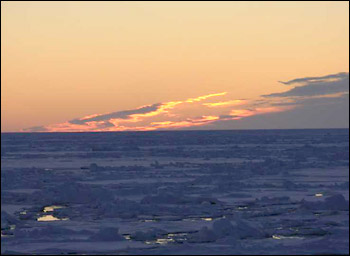Please note: You are viewing
the unstyled version of this website. Either your browser does not support CSS
(cascading style sheets) or it has been disabled. Skip
navigation.
Mike Dempsey, Oceanetic MeasurementSeptember 5, 2006
In the past 40 years, oceanographic research has benefited greatly from satellite remote sensing. Satellites give us an overview of ocean processes that we can not experience from Earth. This exterior perspective on our world has improved our knowledge of how the ocean and atmosphere interact. Out here, we use satellite imagery for predicting ice cover, but for the small detail, ice observers fill in the gaps. Satellites map phytoplankton blooms and measure sea surface heights. In the field, we directly measure ocean currents and profile the water column for chlorophyll concentration to give an added dimension to the satellite imagery. Also often times, ice observations from ships reveal details in small sale ice coverage not perceptible to satellites. Recently we have started to explore the oceans through underwater observatories. All over the world, researches are laying underwater cables out to nodes where many sensors can be hooked up to observe the ocean at all hours of the day, everyday. Through these observatories we can experience the underwater world in the comfort of our homes and offices. Real-time data sets from these observatories allow us to continually monitor events beneath the sea. Observatories offer a tantalizing view of the ocean, but we always wonder what lies beyond their field of view. Observatories can provide incredible resolution in data over time, but are limited in their resolution over area. A mobile platform such as research cruise on a ship provides data in snapshots in time but over a wide area. Satellite communications have allowed us to retrieve data remotely from buoys all over the world. Argo floats, ice buoys and ocean gliders allow scientists to gather ocean profiles routinely from their office. Some instruments gather their data and routinely pass it on through the satellite link. Others have 2 way communications that allows the oceanographer to program the instrument from their desk. So where in this expanded connected world does the role of the oceanographer in the field and research ship fit in? There are still some things you can only experience by being physically there. Out here on the Louis S. St. Laurent, scientists can customize their research to the conditions experienced today. They have years of data sets to compare their observations to and can alter the spacing of their sampling stations and depths to reflect this year's conditions. Especially in the Arctic, ocean processes change over different time scales and the flexibility and mobility a ship offers is the only way to go. Ocean currents driven by atmospheric circulation and heat exchange can alter from year to year. If the water properties show that the movement of a body of water has changed since a previous study, then the sampling can be modified to best examine the new phenomena. On a ship or on the ice, oceanographers can experience the physicality of our environment. Just as Sir Isaac Newton postulated his theories on gravity while sitting below an apple tree, oceanographers refine their views of the ocean while at sea. For me the greatest effect of being close up to the sea is to be continually reminded of its awesome beauty and power. The other day, I watched as two sheets of new ice were pushed into each other at the side of the ship while on station. The edges first crumpled into perfect miniature pressure ridges and then the ice broke up into smaller pans imitating the larger floes. On station during a rosette cast, I watched as the larger floes interacted with the wind, the ship and each other performing an intricate ballet. Like a child's sliding puzzle, the house-sized floes gave meaning to the satellite imagery we consult every spring where ice as big as cities dance around the Beaufort Sea. While steaming through the ice we sometimes witness polar bears walking on the floes. Understanding that polar bears hunt seals, and seeing the variety of ice floes where they hunt are two different experiences. Ridges to stalk behind as well as the seals breathing holes are both visible sometimes in the same view. Some describe polar bears as marine mammals because of their reliance on holes in the ice to hunt their food. I find that seeing a polar bear sliding into a lead and swimming to the next flow helps me to understand their tremendous adaptations to this frozen sea. Oceanography to me means going into the field in all seasons of the year to experience this part of our environment. The larger processes and theories become real to me when I can first-hand experience them in action. When I design a new piece of equipment for research, I fondly remember the conditions I have seen where it may be used. I think of the cold and the ice, the wind and the waves and the algae and the salt. All of these sensations as well as the feel of ocean whether warm or cold embody oceanography for me. For me, it is always important to get wet while studying the ocean. Last updated: October 7, 2019 | |||||||||||||||||||
Copyright ©2007 Woods Hole Oceanographic Institution, All Rights Reserved, Privacy Policy. | |||||||||||||||||||





